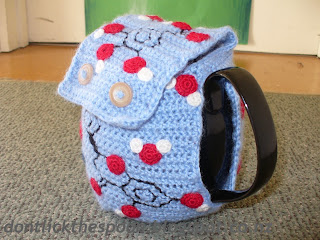For Halloween last year I dressed up as the Bee Girl from the Blind Melon No Rain video clip:
As part of my costume, I crocheted a stripey yellow and black hat and some sleeves to match. I'll put up the patterns for both, starting with the hat.
Hat Pattern
Pattern uses:
5.5 mm crochet hook
~30 g 8 ply yellow wool
~50 g 8 ply black wool
In black wool:
r1 ch4, 63
foundation dc, join with a sc in 3rd ch (64 dc)
r2 sc over the top of the joining sc, ch2, dc in the spaces between dc around, join with a sc in 2nd ch
r3 change colour by incorporating the yellow thread in the last loop of the joining sc (don't cut black), sc over top of join, ch2, dc in spaces, join with a sc
r4 repeat r2
Repeat rows 3 and 4 alternating yellow and black until have 8 stripes. On rows 7 and 11, join with a sl st, sl st in the space between the ch2 and first dc, sc over the top of the sl st. This puts the join on the opposite side of the ch2, which makes the join line reasonably straight.
r17 repeat r3 (64 dc)
r18 sc over top of join, ch2, dec, 5dc, dec, *6dc, dec* x6, 6dc, join with sc (56 dc)
r19 change to yellow. Sc over top of join, ch2, dc, dec, 4dc, dec, *5dc, dec* x6, 4dc, join with sc (48 dc)
r20 sc over top of join, ch2, 2dc, dec, 3dc, dec, *4dc, dec* x6, 2dc, join with sc (40 dc)
r21 change to black. sc over top of join, ch2, 3dc, dec, 2dc, dec, *3dc, dec* x5, 4dc, join with sc (32 dc)
r22 ch3, dec starting in the same gap (the two 'feet' of the dec should be on either side of the sc, ch2 from the previous row), *2dc, dec* x7, 2dc, join with sc (24 dc)
r23 change to yellow. sc over top of join, ch2, dec, *dc, dec* x7, join with sc (16 dc)
r24 sc over top of join, ch2, dec x8, join with sc (9 dc)
r25 change to black. sc over top of join, ch2, dec x4, join with sc. Fasten off and stitch tail though tops of stitches to close hole.
I have a reasonably large head (59 cm), and I made the hat to be a bit loose so it would breathe, so bear that in mind when making this pattern. It should be easy enough to lose a few stitches here and there, or to use a smaller hook - just remember that because of the looseness of the stitch, it's necessary to do two rounds to get an accurate idea of the size.
























